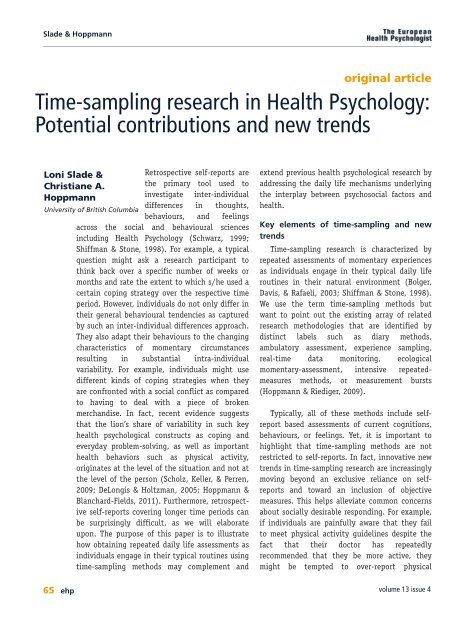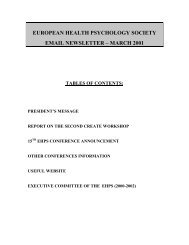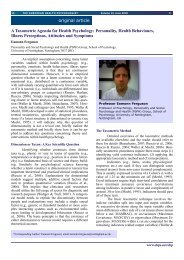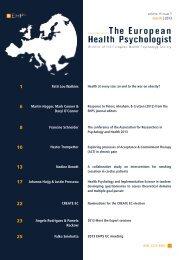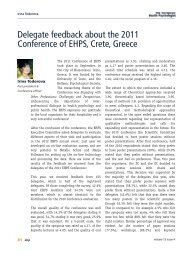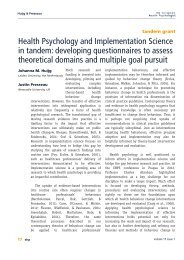PDF download entire issue - European Health Psychology Society
PDF download entire issue - European Health Psychology Society
PDF download entire issue - European Health Psychology Society
Create successful ePaper yourself
Turn your PDF publications into a flip-book with our unique Google optimized e-Paper software.
Slade & Hoppmann<br />
original article<br />
Time-sampling research in <strong>Health</strong> <strong>Psychology</strong>:<br />
Potential contributions and new trends<br />
Loni Slade &<br />
Retrospective self-reports are<br />
Christiane A. the primary tool used to<br />
Hoppmann<br />
investigate inter-individual<br />
differences in thoughts,<br />
University of British Columbia<br />
behaviours, and feelings<br />
across the social and behavioural sciences<br />
including <strong>Health</strong> <strong>Psychology</strong> (Schwarz, 1999;<br />
Shiffman & Stone, 1998). For example, a typical<br />
question might ask a research participant to<br />
think back over a specific number of weeks or<br />
months and rate the extent to which s/he used a<br />
certain coping strategy over the respective time<br />
period. However, individuals do not only differ in<br />
their general behavioural tendencies as captured<br />
by such an inter-individual differences approach.<br />
They also adapt their behaviours to the changing<br />
characteristics of momentary circumstances<br />
resulting in substantial intra-individual<br />
variability. For example, individuals might use<br />
different kinds of coping strategies when they<br />
are confronted with a social conflict as compared<br />
to having to deal with a piece of broken<br />
merchandise. In fact, recent evidence suggests<br />
that the lion’s share of variability in such key<br />
health psychological constructs as coping and<br />
everyday problem-solving, as well as important<br />
health behaviors such as physical activity,<br />
originates at the level of the situation and not at<br />
the level of the person (Scholz, Keller, & Perren,<br />
2009; DeLongis & Holtzman, 2005; Hoppmann &<br />
Blanchard-Fields, 2011). Furthermore, retrospective<br />
self-reports covering longer time periods can<br />
be surprisingly difficult, as we will elaborate<br />
upon. The purpose of this paper is to illustrate<br />
how obtaining repeated daily life assessments as<br />
individuals engage in their typical routines using<br />
time-sampling methods may complement and<br />
extend previous health psychological research by<br />
addressing the daily life mechanisms underlying<br />
the interplay between psychosocial factors and<br />
health.<br />
Key elements of time-sampling and new<br />
trends<br />
Time-sampling research is characterized by<br />
repeated assessments of momentary experiences<br />
as individuals engage in their typical daily life<br />
routines in their natural environment (Bolger,<br />
Davis, & Rafaeli, 2003; Shiffman & Stone, 1998).<br />
We use the term time-sampling methods but<br />
want to point out the existing array of related<br />
research methodologies that are identified by<br />
distinct labels such as diary methods,<br />
ambulatory assessment, experience sampling,<br />
real-time data monitoring, ecological<br />
momentary-assessment, intensive repeatedmeasures<br />
methods, or measurement bursts<br />
(Hoppmann & Riediger, 2009).<br />
Typically, all of these methods include selfreport<br />
based assessments of current cognitions,<br />
behaviours, or feelings. Yet, it is important to<br />
highlight that time-sampling methods are not<br />
restricted to self-reports. In fact, innovative new<br />
trends in time-sampling research are increasingly<br />
moving beyond an exclusive reliance on selfreports<br />
and toward an inclusion of objective<br />
measures. This helps alleviate common concerns<br />
about socially desirable responding. For example,<br />
if individuals are painfully aware that they fail<br />
to meet physical activity guidelines despite the<br />
fact that their doctor has repeatedly<br />
recommended that they be more active, they<br />
might be tempted to over-report physical<br />
65 ehp volume 13 <strong>issue</strong> 4


